Explore the latest insights from top science journals in the Muser Press daily roundup (September 22, 2025), featuring impactful research on climate change challenges.
In brief:
Wildfires are changing the air we breathe – here’s what that means for your health
As wildfires grow larger and more frequent across the West, researchers from Colorado, Utah, and California are digging into how smoke affects the air – and our health.
In a new study published in the journal Atmospheric Environment, the team shows that large wildfires, like those we’ve seen in Colorado, Oregon, and California in recent years, produce large amounts of ozone into the atmosphere. This not only impacts our lungs and other health concerns but also contributes to the warming of the planet.
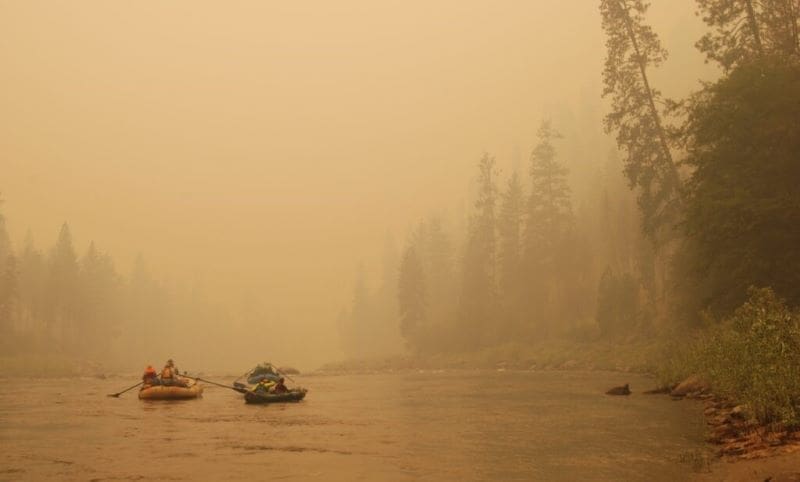
CU Denver mathematics professor emeritus Jan Mandel was part of the research team, which included faculty from the University of Utah (UT) and San Jose State University. The study was led by Derek Mallia, a research assistant professor of Atmospheric Sciences at UT, who has long collaborated with Mandel on wildfire modeling.
The team focused on large wildfires in 2020 that affected much of the Western United States. From Aug. 15-26, 2020, wildfires burned more than 1 million acres across seven northern California counties, causing $12 billion in damage. Dozens of fires raged elsewhere, including Utah’s 90,000-acre East Fork fire and Oregon’s Lionshead and Beachie Creek fires that burned a combined 400,000 acres. During that same time, multiple air quality and pollutant alerts were issued in Colorado as residents dealt with smoke-filled skies.
Mandel developed most of the computer code used to model the wildfire chemical emissions that ended up in the atmosphere. He worked alongside Mallia and Adam Kochanski, associate professor at San Jose State University, both longtime collaborators.
“Wildfires do not emit ozone directly,” Mandel said. “Wildfire smoke contains chemical compounds that react with sunlight to produce ozone, often far from the fire itself. Modeling this requires sophisticated atmospheric chemistry and weather prediction software, which we integrated with our wildfire model.”
The research paper concludes that, on average, the presence of wildfire smoke increases ozone concentrations by 21 parts per billion (ppb). That is on top of already high ozone levels in the West, pushing concentrations beyond the 70-ppb health standard set by the U.S. Environmental Protection Agency.
Ozone is a health hazard. The Colorado Department of Public Health & Environment states that symptoms can range from coughing to lung and cardiovascular disease and, in some cases, premature death.
Journal Reference:
Derek V. Mallia, Cambria White, Angel Farguell, Jan Mandel, Adam K. Kochanski, ‘Simulating the impacts of regional wildfire smoke on ozone using a coupled fire-atmosphere-chemistry model’, Atmospheric Environment 360, 121404 (2025). DOI: 10.1016/j.atmosenv.2025.121404
Article Source:
Press Release/Material by Zenaida Kotala Gonzalez | University of Colorado Denver (CU Denver)
Ice dissolves iron faster than liquid water
The study, recently published in the scientific journal PNAS, shows that ice at minus ten degrees Celsius releases more iron from common minerals than liquid water at four degrees Celsius. This challenges the long-held belief that frozen environments slow down chemical reactions.
“It may sound counterintuitive, but ice is not a passive frozen block,” says Jean-François Boily, Professor at Umeå University and co-author of the study. “Freezing creates microscopic pockets of liquid water between ice crystals. These act like chemical reactors, where compounds become concentrated and extremely acidic. This means they can react with iron minerals even at temperatures as low as minus 30 degrees Celsius.”
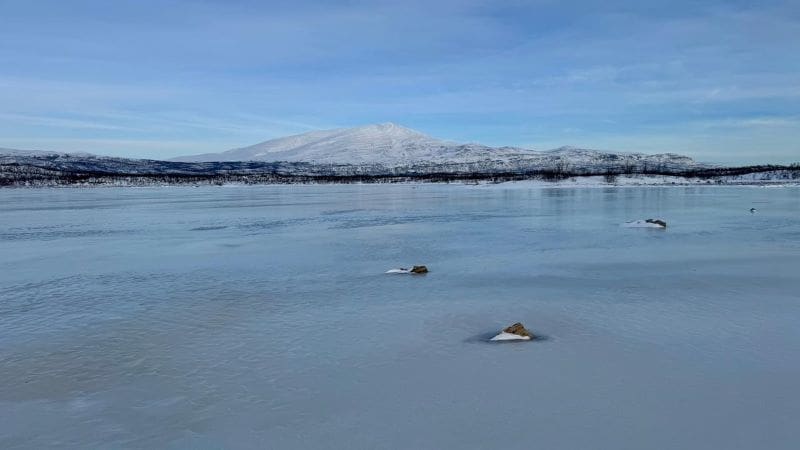
To understand the process, the researchers studied goethite – a widespread iron oxide mineral – together with a naturally occurring organic acid, using advanced microscopy and experiments.
They discovered that repeated freeze-thaw cycles make iron dissolve more efficiently. As the ice freezes and thaws, organic compounds that were previously trapped in the ice are released, fuelling further chemical reactions. Salinity also plays a crucial role: fresh and brackish water increase dissolution, while seawater can suppress it.
The findings apply mainly to acidic environments, such as mine drainage sites, frozen dust in the atmosphere, acid sulfate soils along the Baltic Sea coast, or in any acidic frozen environment where iron minerals interact with organics. The next step is to find out if the same is true for all iron-bearing ice. This is what ongoing research in the Boily laboratory will soon reveal.
“As the climate warms, freeze-thaw cycles become more frequent,” says Angelo Pio Sebaaly, doctoral student and first author of the study. “Each cycle releases iron from soils and permafrost into the water. This can affect water quality and aquatic ecosystems across vast areas.”
The findings show that ice is not a passive storage medium, but an active player. As freezing and thawing increase in polar and mountain regions, for the impact on ecosystems. and the natural cycling of elements could be significant.
Journal Reference:
A.P. Sebaaly, F. van Rijn, K. Hanna & J. Boily, ‘Ice as a kinetic and mechanistic driver of oxalate-promoted iron oxyhydroxide dissolution’, Proceedings of the National Academy of Sciences U.S.A. 122 (35) e2507588122 (2025). DOI: 10.1073/pnas.2507588122
Article Source:
Press Release/Material by Sara-Lena Brännström | Umeå University
Grouped climate solutions for better production: Science listening to West African farmers
The rain delays, sorghum withers; when a storm finally breaks, complaints rise again. To break this cycle of uncertainty, scientists from the Alliance of Bioversity International and CIAT, INERA, and the University of Ghana conducted the first large-scale survey on agricultural climate services in Burkina Faso, Ghana, Mali, and Senegal.
Published in Frontiers in Climate, the study analyzes the expectations of 1,212 farmers and charts a credible path to turn weather reports into a profitable investment. Lead researchers include: Adama Ouedraogo, Mathieu Ouedraogo, Irene S. Egyir, Peter Läderach, Akwasi Mensah-Bonsu, and John Baptist D. J. Jatoe.
Data that speaks farmers’ language
Under the West African sky, the weather has become the determining factor of every farming season. One hundred percent of respondents reported experiencing drought in the past decade; one in two has seen lowlands flooded by unexpected rains, and more than a third recalls harvests scorched by heat waves. Add to this the winds that flatten millet, the gusts that blow off granary roofs, and the pests that proliferate after late rains. The result: farmers face impossible bets – should they sow early to catch rare rains or delay planting and risk missing the market window?
Yet when a reliable forecast arrives on time, the benefits verge on an economic miracle. Studies in Niger and Ethiopia show that a simple seasonal SMS, combined with advice on which variety to plant, can boost gross margins by over 20% per season.
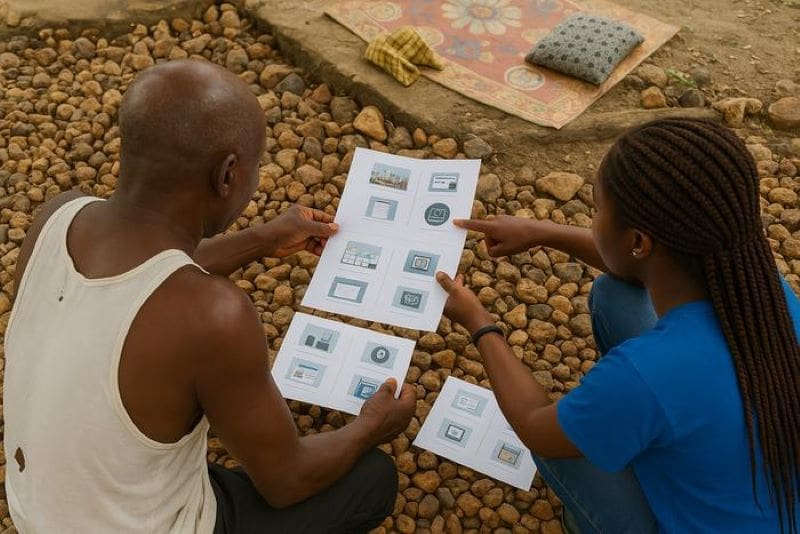
But the survey reveals an unexpected gap: barely one in ten farmers relies on scientific information; most still watch the flowering of the néré tree, test early-maturing varieties, or move their herds to lowlands to limit losses. The issue is not the lack of weather data – it exists – but the absence of local anchoring: messages in French where Bambara is spoken, forecasts sent after the hoe is already stored, discouraging subscription fees. This information divide is compounded by an illiteracy rate of nearly 74% in Burkina Faso and often empty cash reserves, without which advice remains a dead letter. In these conditions, weather is seen as a diagnosis without a prescription: useful, but powerless if not paired with climate insurance and input credit.
The study draws a clear conclusion: with the right financial support, rain becomes an ally rather than a threat.
Decoding farmers’ preferences: From bundle design to choice hierarchy
To untangle what producers truly want, the researchers created a choice experiment worthy of a traveling lab. Five “bundles,” mixing weather forecasts at different time scales, seed or plant-health advice, drought-indexed insurance, microcredit, and market information, were presented to 1,212 farmers. Each participant evaluated multiple scenarios, selected their preferred package, and chose their favorite delivery channel: SMS, community radio, or interactive voice server.
The vote revealed a clear winner: Bundle 4 – combining daily weather, tailored seed advice, drought insurance, and seasonal credit – captured 45% of preferences. The minimalist, free Bundle 0, without weather data, drew only 22%. Regional nuances stand out: in Mali, producers favor varietal expertise to secure planting; in Ghana, insurance drives decisions; in Burkina Faso, access to credit weighs heavily in cash-strapped farms.
Econometric models confirm that the perceived value of a service rises as information becomes more frequent and prescriptive: “plant on June 15, use variety X, fertilize at rate Y.” In contrast, weekly forecasts or generic Sunday radio programs barely influence decisions. Despite language barriers, SMS remains the most reliable messenger; its low cost and speed offset high illiteracy, especially when paired with clever pictograms translating clouds and raindrops into clear images.
This fine-tuned approach even quantifies “willingness to pay”: one day of ultra-local forecasting is worth an average of USD 0.70 to a Senegalese farmer, while drought insurance represents USD 1.30 to a Ghanaian peer. Better yet, these amounts vary by crop (irrigated rice tolerates more risk than rainfed millet) and by farm size, suggesting tiered pricing and targeted subsidies to drive massive adoption.
The winning bundle: farmers want a combination of short- and long-term insights
Bundle 4 stands out because it unites two key levers: anticipation and protection. Adding a USD 1,000 loan raises the likelihood of adoption by 39%, yet even without this incentive it remains the favorite. Drought, viewed as public enemy number one, underscores the point: when researchers simulate its doubling over the next decade, nearly 60% of respondents flock to Bundle 4. In practice, daily weather tells them when to sow, insurance promises compensation if clouds fail, and the loan finances seeds, fertilizer, or labor.
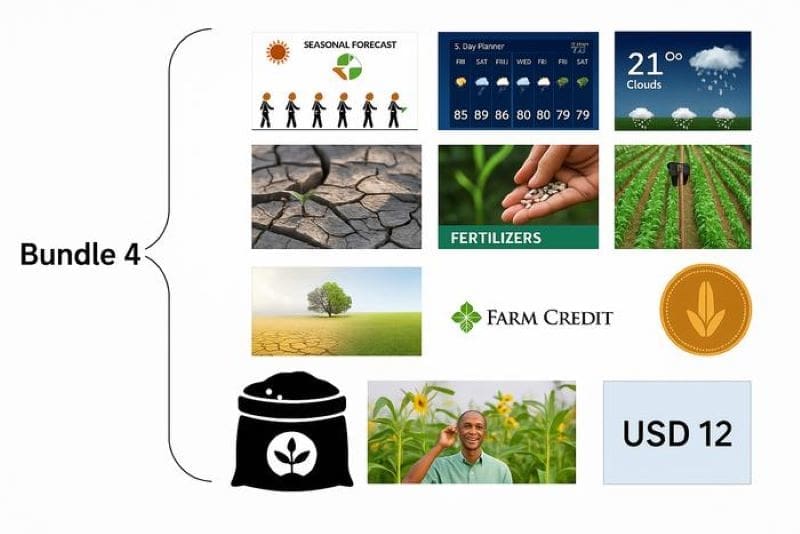
Farmers also see the circular logic: precise weather data boosts the relevance of insurance, which reassures lenders in case of default, unlocking low-interest credit. No surprise that 62% cite forecast reliability as the top criterion before signing a loan. This interaction echoes index-insurance trials in Senegal’s peanut basin: without granular weather data, trust erodes, policies sell poorly, and banks hold back.
Bundle 4 attracts for another reason: cost sharing. Instead of paying three separate subscriptions, the farmer pays one fee; the provider, in turn, spreads satellite data collection, SMS dispatch, claims management, and loan administration over a single client base. In projected models, when national meteorological services, insurtech start-ups, microfinance NGOs, and input suppliers join forces, the marginal cost of each service can fall by 40%. Integration is not just convenient for users – it creates economies of scale that secure provider profitability.
From Results to Action: Six Priorities for Policy and Social Enterprise
At the end of the survey, one truth stands out: for weather to become a lever for smallholder action, it must go well beyond a simple radio bulletin. The effectiveness of a climate service depends on its ability to fit into a full support ecosystem tailored to field realities and family-farm constraints. Researchers identify six strategic priorities for governments, social enterprises, NGOs, and private operators.
- Invest in prescriptive information
Farmers need useful, contextual messages that help them decide here and now. An alert specifying the optimal sowing date or watering time is worth far more than a vague forecast, generating the highest marginal utility.
- Link insurance and credit
Insurance protects against risk, credit finances adoption of technical advice. Together, these levers let farmers test, invest, and innovate without fear of total loss – the clearest leverage effect observed in the survey.
- Diversify delivery channels
SMS works but is not enough. Interactive voice reaches low-literacy audiences, including nomadic herders. Mobile apps can appeal to youth seeking digital, personalized solutions.
- Segment offerings by crop and profile
An irrigated market gardener has different needs from a lowland rice grower or a rainfed cowpea producer. Modular packages adapted to context drive better adoption.
- Integrate local knowledge and endogenous practices
All respondents still observe traditional signs – bird behavior, tree flowering, wind direction. Recognizing these cues and linking them to scientific data strengthens service ownership.
- Build a sustainable business model
Differential pricing, targeted subsidies for the most vulnerable, and a public–private partnership approach are key to reducing costs without compromising quality. The goal: make these services viable in the long run.
The authors recommend firmly embedding Bundle 4 in national policies while maintaining a free Bundle 0 for universal access. Governments can subsidize initial insurance premiums, telecom operators can offer climate SMS at social rates, and research centers can refine forecast precision down to plot level. In West Africa and beyond, this strategy would put farmers back at the heart of the alert and action system.
Journal Reference:
Ouedraogo A, Ouedraogo M, Egyir IS, Läderach P, Mensah-Bonsu A and Jatoe JBD, ‘Climate services bundles preferences of smallholder farmers in West Africa: a stated choice modelling’, Frontiers in Climate 7: 1581001 (2025). DOI: 10.3389/fclim.2025.1581001
Article Source:
Press Release/Material by The Alliance of Bioversity International and the International Center for Tropical Agriculture (CIAT)
LEDs shed light on efficient tomato cultivation
Researchers including those from the University of Tokyo have successfully grown large tomatoes and cherry tomatoes, both rich in nutrients, in tightly controlled environments where the light source was energy-efficient LEDs. Such methods were often limited by the types or sizes of plants that could thrive in such conditions. This feasibility study demonstrates the researchers’ method is suitable for urban environments, potentially even in space, and can offer food security in the face of climate change or extreme weather conditions.
Pizza, pasta, soup, salad, the tomato really is a versatile and delicious food crop. Its delicious and nutritious nature comes with a cost though; it has a very high demand for light, as well as water.
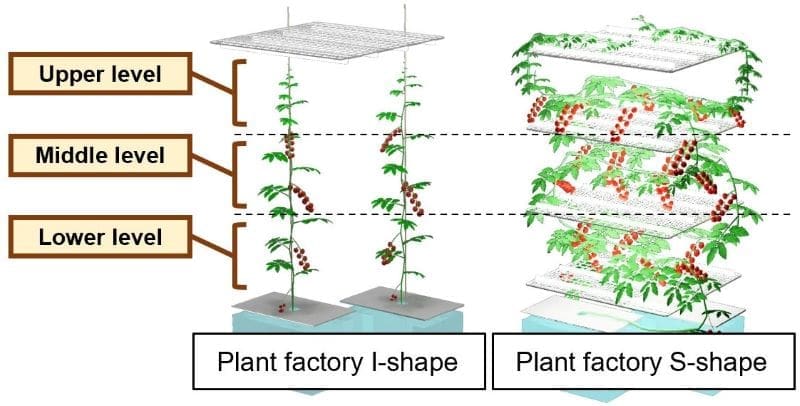
While tomatoes grow well in some parts of the world, there are many regions where the local climate is not ideally suited to them, and with climate change exacerbating weather and the environment, having a way to improve yields or enable cultivation at all have long been sought. Greenhouses are the main method for creating a controlled environment suitable for growing crops, including tomatoes, but they have drawbacks and still rely on natural sunlight, which can be a limiting factor in some areas. If you’ve ever bought greenhouse-grown tomato soup in Iceland for example, you may have realized this all too well.
There has been some research and even agricultural use of artificial light plant factories (ALPFs), which are exactly what they sound like: fully controlled environments tailored to specific crops to maximize yields without compromising on other factors. These have a proven track record but require a lot of power to operate due in part to the lighting they require.
A logical step is to use energy-efficient LED lights, which has been successful for certain crops such as leafy greens, but nothing more substantial. Spinach and lettuce are nice, but they’re no slice of pizza. Realizing this limitation, Associate Professor Wataru Yamori from the Graduate School of Agricultural and Life Sciences at the University of Tokyo and his team decided to refine this concept to make it bear fruit.
“Plant factories are resilient to climate extremes such as droughts, floods and heat waves that increasingly disrupt traditional farming. They can be built in deserts, cities, or one day even in space. By bringing production closer to consumption, they help reduce both climate risk and food transport needs,” said Yamori.
“For many years, people assumed that crops with relatively long cultivation periods that require high light intensity, such as large-fruited tomatoes, could not thrive under LEDs. Our earlier work proved that cherry tomatoes, and even edamame, could be grown in such systems. Testing large tomatoes was the next logical challenge, pushing the boundaries of what plant factories can do.”
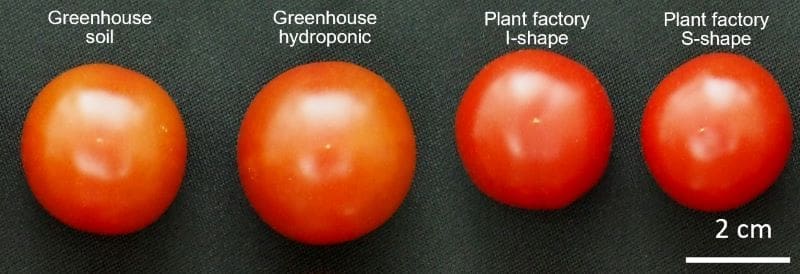
The team did more than just change a few lightbulbs out for LEDs though. They firstly fit an enclosed factory space with the standard materials necessary for growing tomatoes, but introduced different lighting setups, both using high-efficiency LEDs, depending on which variety of tomatoes they were growing. Over the course of a year, they lit large-fruited tomato plants from above, coaxing them to grow straight upwards as you’d expect. But the second setup involved lighting smaller cherry tomato plants from either above or from the sides, in such a way that they grew upwards in an S-shape series of bends.
The larger tomato plants grew well but didn’t quite match the yields or sugar content when compared with greenhouse-grown plants, though they did have more vitamin C. As for the cherry tomatoes, these exceeded expectations, with similar yields to greenhouses but significantly higher quality. In addition, the S-shaped plants fruited sooner, further increasing yields.
“Our study demonstrates that large-fruited tomatoes, once considered too difficult to grow under artificial lighting, can be stably cultivated in a fully-enclosed LED plant factory. This marks a turning point as LED factories, usually thought suitable only for leafy greens, can also support demanding fruiting vegetables like tomatoes,” said Yamori. “At present, greenhouse-grown tomatoes still tend to be larger and sweeter. But LED-grown tomatoes offer improved consistency. They maintain stable quality year-round and are often richer in nutrients like vitamin C. With continued improvements, we expect factory tomatoes to match, or even surpass, greenhouse ones in taste.”
Of course, anyone who’s ever tried (and especially those who failed) to grow demanding crops like tomatoes knows all too well that there are many factors to control in order to cultivate them.

“Perhaps the biggest hurdle was optimizing the light environment. Large tomatoes need plenty of energy for both growth and ripening, and it wasn’t clear whether LEDs could provide enough. But balancing light, temperature, humidity and nutrients in a closed space required a great deal of trial and error,” said Yamori.
“LED-grown tomatoes are likely to appear first in regions where traditional farming is difficult, or where transport costs are high. They also fit well with the idea of ‘local production for local consumption,’ something that could be harvested in the city and eaten fresh, without long supply chains. Costs are still a little higher, but as the technology spreads and renewable energy is integrated, prices will become more affordable.”
It may still take a while before your local salad bar grows its own crops, but the possibilities extend even beyond that.
“Vertical tomato farms in skyscrapers are not science fiction anymore. Pilot projects exist around the world, though mostly for leafy greens,” said Yamori. “With our results, it’s realistic to imagine tomatoes being grown in skyscrapers within 10 to 20 years, and even in experimental systems for growing fresh produce on the moon or Mars.”
Journal Reference:
Qiu, N., Shen, H., Ishizuka, D., Yatsuda, K., Kawabata, S., Qu, Y., & Yamori, W., ‘Harnessing LED Technology for Consistent and Nutritious Production of Large-fruited Tomatoes’, HortScience 60 (11), 1851–1859 (2025). DOI: 10.21273/HORTSCI18868-25
Furuta H, Qu Y, Ishizuka D, Kawabata S, Sano T and Yamori W, ‘A novel multilayer cultivation strategy improves light utilization and fruit quality in plant factories for tomato production’, Frontiers in Horticulture 4: 1633097. DOI: 10.3389/fhort.2025.1633097
Tomoki Takano, Yu Wakabayashi, Soshi Wada, Toshio Sano, Saneyuki Kawabata, Wataru Yamori, ‘Sustainable Edamame production in an artificial light plant factory with improved yield and quality’, Scientific Reports 15, 32083 (2025). DOI: 10.1038/s41598-025-17131-w
Article Source:
Press Release/Material by University of Tokyo (UTokyo)
Featured image credit: Gerd Altmann | Pixabay




